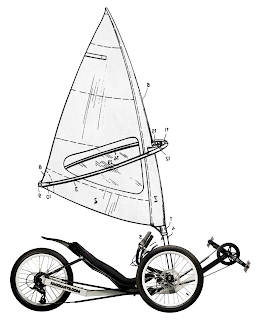And Steve's Special Kind of Clunkerbike Crazy is...
The Tradewinds concept! While not strictly to scale, it is kind of the scale I'm aiming for, a 3x20" tadpole trike for a 182cm tall guy, onroad and offroad, with a collapsable mast and bow-boomed, loose footed rig of recycled coffee bean bag reflective mylar. Gunna defs build the trike part first, though. No point hitching a horse when their's no cart. (Trike image credit: KMX Karts, with mods by Crunchy.)
The primary design consideration here is "wind assist", not monstrously wind propelled to the point of dangerous. The Whike (whike.com), for instance, has a "storm rig" option for higher winds. I figure I'll start with a storm rig first, and see what the thrust and tipping forces are like. Also, my primary concern for adding a sail is as much urban visibility, as it is for transport. Might cause some bailful looks from "Mr Plod", though, so even that may not be a common use for it.
For offroad exploring, through the bike sections of the Goldfields Track, for example, or a Nullabor crossing, especially, this could be a fantastic adventure, without the strain of pedalling for hours a day, or range and weight issues of electric pedal assist. And lets face it, if being visible also increases your range, the odd pulldown in order to keep a skeptical copper at ease, is no problem at all.
Now, I'm pretty sure some readers are saying, "The biggest problems for riders are winds from the front!" and yeah, this is true. However, by making the rig demountable, and the fact that recumbent trikes are low to the wind, there's no problem with a full headwind. A cove's just gotta knuckle under and pedal.
Also, what about "quarter winds?" These are winds on a fore reach, 45° off the direction of travel. This is where the modern triangular, loose-footed sail works brilliantly! A battened, triangular sail is effectively a wing, providing lift across the top of the curvature. If there's a 90° crosswind, the sail is pointed opposite to the crosswind with just enough tilt to fill the sail and create a lift force in the direction of travel. This lift force is generated, not by pushing the sail aside, rather it's nearly all down to the wing shape of the fill sail creating a low pressure in front and a high pressure behind. At a 45° angle against the direction of travel, this thrust value provided by the lifting forces over the top of the sail's curve is still generated when pointing the it such that it fills enough to fully curve without luffing (the flap a poorly tuned sail makes), then the wheels vector this force torwards the direction of travel. The net result is a true forwards force that is the lift force divided by the square root of 2, and still 71% of the forwards force of a full reach at 90°.
Sailing is trigonometry! I bet those kids at high school, the ones who called me "Poindexter", are looking sheepish now. I know how to make the wind do my bidding... mostly... when it's favourable... LOLS.
Image credit: Pinterest.



Comments
Post a Comment